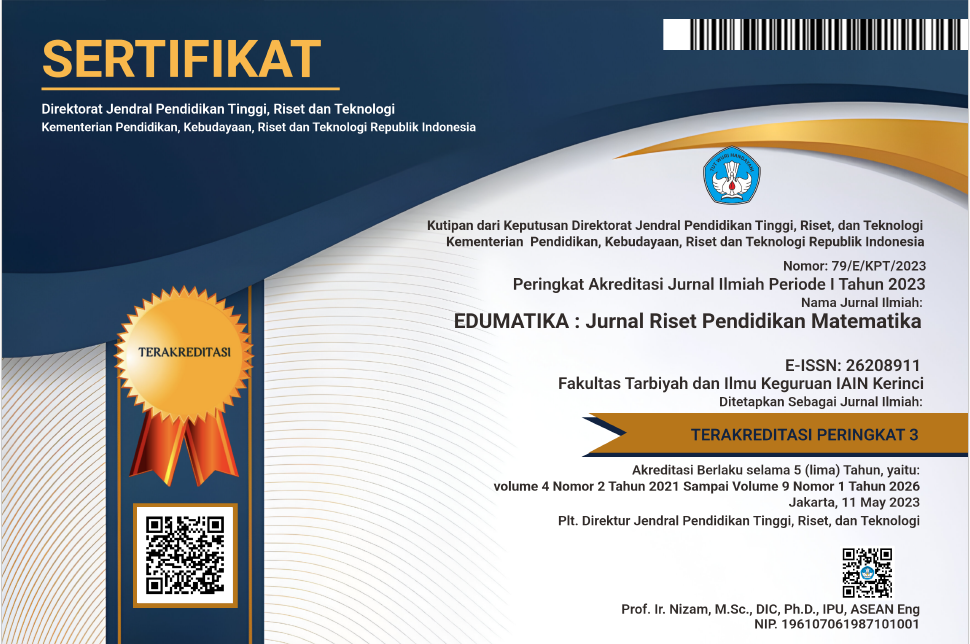The Analysis of Students’ Critical Thinking Skills in Determining Plane Figure Properties
Abstract
The plane figure is compulsory mathematics material at all levels of education, including junior high school. However, students still make frequent mistakes in understanding the plane figures' properties. In understanding this topic, students must have the skill to think critically. Critical thinking is a process of rational thinking before deciding or taking action in a more specific direction. Therefore, this study aims to determine students' skills in defining the plane figure's properties. The method used in this research is a qualitative research method. Tests and interviews were used to determine the students' skills in determining the properties of the plane figure. Researchers determined five indicators used to determine students' skills in determining the nature of the plane figure: focusing and formulating, observing and assessing observation results, making and assessing inductions, defining and assessing definitions, and integrating decisions. Three junior high school students were selected as research subjects with high, medium, and low skill levels, respectively. The data analysis used descriptive analysis using method triangulation and theory triangulation. The research results show two students' mathematical critical thinking patterns based on their skills. The subjects with high and medium skills can solve all problems with a small error rate and fulfill all predetermined critical thinking skills indicators. On the other hand, the subject with low skills has not been able to solve problems, so no critical thinking indicators are met. There is a misunderstanding on high and moderate skills subjects. Neither understand the meaning of opposite angles and parallel lines in specific plane figures. It can be a reference for teachers to improve students' understanding of mathematical concepts.
Downloads
References
Agoestanto, A., & Sukestiyarno, Y. L. (2017, March). Analysis of mathematics critical thinking students in junior high school based on cognitive style. In Journal of Physics: Conference Series (Vol. 824, No. 1, p. 012052). IOP Publishing.
Ashari, N. W., & Salwah, S. (2017). Problem based learning (PBL) dalam meningkatkan kecakapan pembuktian matematis mahasiswa calon guru. JMPM: Jurnal Matematika dan Pendidikan Matematika, 2(2), 100-109.
Ashari, N. W., & Ilyas, M. (2018, June). Working with Definition of Absolute Value: Study on Prospective Mathematics Teacher of Cokroaminoto Palopo University in Real Analysis Subject. In Journal of Physics: Conference Series (Vol. 1028, No. 1, p. 012139). IOP Publishing. https://doi.org/10.1088/1742-6596/1028/1/012139
Basri, H., & As'ari, A. R. (2019). Investigating Critical Thinking Skill of Junior High School in Solving Mathematical Problem. International Journal of Instruction, 12(3), 745-758.
Braun, V., & Clarke, V. (2013). Using thematic analysis in psychology. Qualitative Research in Psychology, 3(2), 77–101. http://dx.doi.org/10.1191/1478088706qp063oa
Chisara, C., Hakim, D. L., & Kartika, D. H. (2019). Implementasi Pendekatan Realistic Mathematics Education (RME) dalam Pembelajaran Matematika. In Prosiding Seminar Nasional Matematika Dan Pendidikan Matematika (Sesiomadika) (Vol. 1, No. 1b. p. 65–72).
Dahniar, D., Salwah, S., & Ekawati, S. (2021). Deskripsi Kemampuan Berpikir Kritis Matematis Awal Siswa SMP Negeri 2 Bua Kelas VIII Melalui Pendekatan Inquiry. Pedagogy: Jurnal Pendidikan Matematika, 6(2), 71–81.
Ennis, R. H. (2015). Critical thinking: A streamlined conception. In The Palgrave handbook of critical thinking in higher education (pp. 31-47). Palgrave Macmillan, New York.
Fuadah, F. (2016). Profil Kemampuan Koneksi Matematika Siswa Dalam Menyelesaikan Masalah Matematika Pada Pembelajaran Matematika Dengan Model Air (Auditory, Intellectually, Repetition) Ditinjau Dari Kemampuan Matematika (Doctoral dissertation, UIN Sunan Ampel Surabaya).
Isrokatun, I., Hanifah, N., Maulana, M., & Suhaebar, I. (2020). Pembelajaran Matematika dan Sains secara Integratif melalui Situation-Based Learning. UPI Sumedang Press.
Istianah, E. (2013). Meningkatkan kemampuan berpikir kritis dan kreatif matematik dengan pendekatan model eliciting activities (MEAs) pada siswa SMA. Infinity Journal, 2(1), 43-54.
Karim, A. (2014). Pengaruh Gaya Belajar Dan Sikap Siswa Pada Pelajaran Matematika Terhadap Kemampuan Berpikir Kritis Matematika. Formatif: Jurnal Ilmiah Pendidikan MIPA, 4(3), 188–195.
Khoirunnisa, P. H., & Malasari, P. N. (2021). Analisis kemampuan berpikir kritis matematis siswa ditinjau dari self confidence. JP3M (Jurnal Penelitian Pendidikan dan Pengajaran Matematika), 7(1), 49–56. https://doi.org/10.37058/jp3m.v7i1.2804
Lestari, S. Z. D., & Roesdiana, L. (2021). Analisis Kemampuan Berpikir Kritis Matematis Siswa Smp Pada Materi Himpunan. MAJU: Jurnal Ilmiah Pendidikan Matematika, 8(1), 82–90.
Nuraini, L., & Ganda, N. (2021). Pengaruh Penerapan Teori Belajar Van Hiele terhadap Hasil Belajar Siswa pada Materi Sifat-Sifat Bangun Datar. Pedadidaktika: Jurnal Ilmiah Pendidikan Guru Sekolah Dasar, 8(2), 395-403.
Nursaidah, A., & Pranata, O. H. (2018). Desain Didaktis Sifat-Sifat Persegi dan Persegi Panjang Berbasis Permainan Tradisional Oray-Orayan di Sekolah Dasar. Pedadidaktika: Jurnal Ilmiah Pendidikan Sekolah Dasar, 5(4), 10–20.
Prajono, R., Gunarti, D. Y., & Anggo, M. (2022). Analisis Kemampuan Berpikir Kritis Matematis Peserta Didik SMP Ditinjau dari Self Efficacy. Mosharafa: Jurnal Pendidikan Matematika, 11(1), 143-154.
Sabandar, J. (2013). Berpikir Reflektif dalam Pembelajaran Matematika. Tersedia di website: http://file. upi. edu/Direktori/FPMIPA.
Safrina, Y., Ikhsan, M., & Zubainur, C. M. (2022, January). Improving Student Geometry Problem-Solving Skills Through Spatial Training. In Eighth Southeast Asia Design Research (SEA-DR) & the Second Science, Technology, Education, Arts, Culture, and Humanity (STEACH) International Conference (SEADR-STEACH 2021) (pp. 30-37). Atlantis Press.
Salwah, S., Ashari, N. W., & Ma’Rufi. (2020). Mathematical critical thinking skill of students grade VII in solving one variable linear equation questions based on their cognitive style. Journal of Physics: Conference Series, 1470(1). https://doi.org/10.1088/1742-6596/1470/1/012010
Salwah, S. (2018). Habit Of Striving For Accuracy And Precision (HSAP) Melalui Pendekatan Realistic Mathematics Education Berbasis Gaya Kognitif. Pedagogy: Jurnal Pendidikan Matematika, 3(1).
Verawati, N. N. S. P., Hikmawati, H., Prayogi, S., & Bilad, M. R. (2021). Reflective Practices in Inquiry Learning: Its Effectiveness in Training Pre-Service Teachers' Critical Thinking Viewed from Cognitive Styles. Jurnal Pendidikan IPA Indonesia, 10(4), 505-514.
Copyright (c) 2022 Nur Wahidin Ashari, Muhammad Ikram, I Luh Sumber Dani

This work is licensed under a Creative Commons Attribution 4.0 International License.















